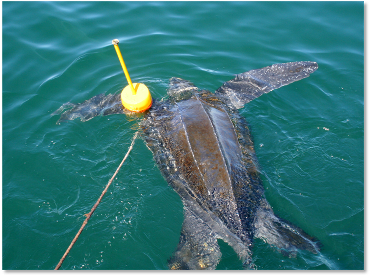
The worldwide decline in leatherback turtles has been caused, in part, by bycatch in fisheries. Leatherback turtles most often entangled or hooked externally in pelagic longline fisheries (Garrison 2003), but are capable of swimming to the surface to breathe (Witzell and Cramer 1995). Although not all incidental captures lead to mortality, the number of leatherbacks caught each year is very high and post release mortality rates are unknown. Lewison et al (2004) estimated that the global longlining fleets took 50 to 60,000 leatherbacks in 2000.
Leatherbacks are also taken in trawl fisheries and entangled in gillnets and pot or trap lines. Mortality rates are higher in trawl and gillnet fisheries because entangled turtles are unable to swim to the surface to breathe. Leatherback have been found entangled in fixed gear in Canada and in US waters from Maine to New York (Dwyer et al 2003). An estimated 3000 leatherbacks interacted with artisanal gillnet fisheries off Trinidad in 2000, where mortality rates were between 28 and 34% (Lee Lum 2003).
One method employed to protect leatherbacks in the North Atlantic is reducing interactions between the turtles and pelagic longline fisheries through an area closure of the Northeast Distant (NED) reporting area. Circle hooks have also successfully decreased bycatch rates of leatherback turtles in some longline fisheries (Gilman et al 2011).
References
Gilman, E, D Kobayashi, T Swenarton, N Brothers, P Dalzell, and I Kinan-Kelly. 2011. REducing sea turtle interactions in the Hawaii-based longline swordfish fishery. Biological Conservation 139: 19-28.
Lewison, RL, SA Freeman, and LB Crowder. 2004. Quantifying the effects of fisheries on threatened species: the impact of pelagic longlines on loggerhead and leatherback sea turtles. Ecology Letters 7(3): 221-344.
